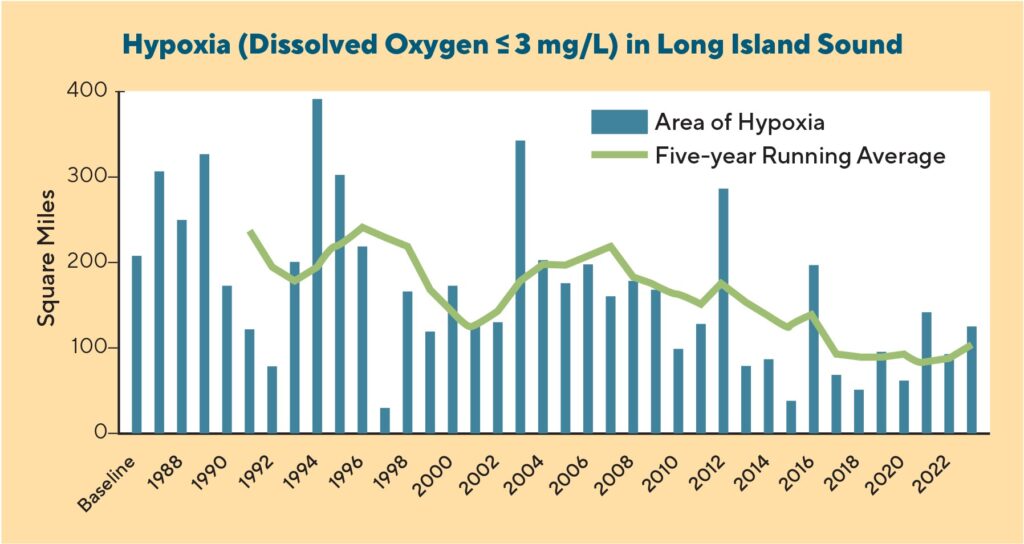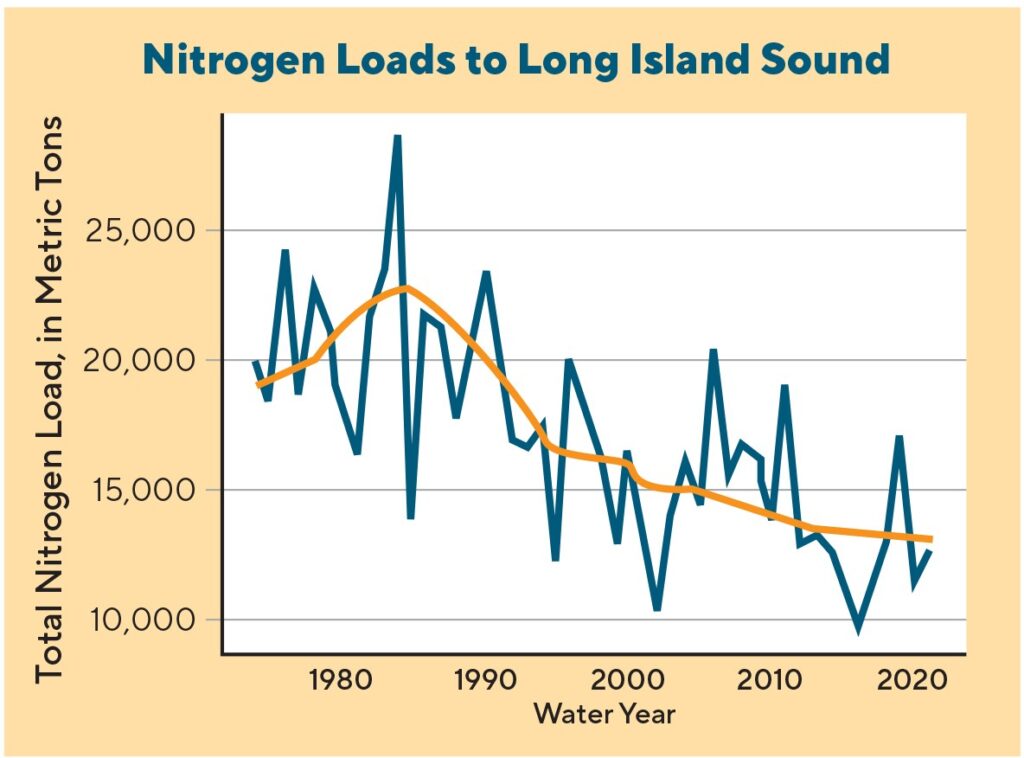By James Ammerman
For decades, the Long Island Sound (LIS), located between New York and Connecticut, has had a chronic problem with bottom water hypoxia, or oxygen depletion, due to nutrient pollution from urban wastewater treatment plants, stormwater, septic systems and fertilizer runoff. These hypoxic waters are unable to sustain life, leading to die-offs of fish and shellfish. However, joint efforts by the U.S. Environmental Protection Agency (EPA) and the surrounding states to tackle the sources of this pollution have resulted in a reduction of the hypoxia area by more than 50% since 2001.
Long Island Sound is an urban estuary with 25 million people living within 50 miles, primarily around New York City, and nine million people living in its watershed. The LIS watershed drains more than 16,000 square miles and stretches all the way to Canada. LIS is unusual in its east-west orientation and being connected to the ocean at both ends. It has a mean depth of about 60 feet and receives 70% of its freshwater from the Connecticut River near the mouth. LIS is part of the Virginian Atlantic Ecoregion, which stretches from Cape Hatteras in North Carolina to Cape Cod in Massachusetts, and includes other estuarine and coastal regions such as Albemarle/Pamlico Sound, Chesapeake Bay, Delaware Bay, New York Bight and Buzzards Bay. This region has been known for oysters, striped bass and other important commercial species, though many have declined from pollution, overfishing or other human impacts.

The EPA, Connecticut and New York established the Long Island Sound Study (LISS) in 1987 to protect the Sound, an estuary of national significance. LIS has had a chronic problem with bottom water hypoxia, which has been monitored during the summer since the late 1980s, and year-round since the 1990s. This hypoxia occurs in the summer months in the western Sound. In 1994, the worst year to date, almost a third of the nearly 1,300 square mile area of the Sound was hypoxic, meaning that the bottom water dissolved oxygen concentration was 3 mg/liter or less.
As a result of this recurring problem, the EPA, along with Connecticut and New York, agreed to a total maximum daily load (TMDL) for nitrogen in 2000. The primary target of the TMDL was point source in-basin wastewater treatment plants in the western Sound, which were required to reduce nitrogen loading by 60%. Additional nitrogen reductions in the TMDL included 10% of in-basin and upper basin non-point sources, and 25% from point source upper basin wastewater treatment plants. Further nitrogen loading decreases were also expected from decreased atmospheric deposition due to Clean Air Act improvements, and in water removal processes like bioextraction by seaweed and shellfish.
The 60% load reduction from western Sound treatment plants was achieved in 2016 after expensive treatment plant upgrades. With $2.5 billion invested since the 2000 TMDL, New York and Connecticut are discharging 49 million fewer pounds of nitrogen annually by sewage treatment plants compared to the early 1990s.
As a result of this nitrogen load reduction, the annual hypoxic area has also been reduced by about 60%, and the most recent five-year rolling average (2019-2023) was 102 mi2. The area varies annually with weather and hydrographic conditions in the Sound, and the reduction was limited until after the major treatment plant upgrades in 2009.

Nonetheless, a recent paper demonstrated that each decade has seen a decline in the hypoxic area (1994, 2004, 2014) (Whitney & Vlahos, 2021).
Even though the water quality has improved, LIS still has numerous challenges. Many of the 115 embayments around the Sound exhibit harmful algal growth and nocturnal hypoxia. Areas of seagrass and salt marsh have also declined. Going forward, researchers at LISS will concentrate nitrogen reduction efforts on three groups of watersheds: coastal, which drain directly into embayments or coastal waters; tributary, which drain inland areas; and the western Sound with large treatment plants which drain directly to the Sound.
Tributary nitrogen loading has also declined, as shown by the Connecticut Fall Line nitrogen load from seven major tributaries to LIS. This is due to improved upstream controls as well as reduced atmospheric deposition. Remaining nitrogen reduction targets from the 2000 TMDL include a 10% reduction of in-basin and upper basin nonpoint sources, and a 25% reduction from point source upper basin wastewater treatment plants. New targets may also be developed in the future.

Current efforts that address these issues include the Connecticut Department of Energy and Environmental Protection’s Second Generation Nitrogen Strategy, which involves increased water quality monitoring and modeling. Similarly, the New York State Department of Environmental Conservation has the Long Island Nitrogen Action Plan, focused on reducing nitrogen loading to ground and surface waters in Nassau and Suffolk counties. The Unified Water Study of Save the Sound and the U.S. Geological Survey have also increased their monitoring and modeling efforts, especially in embayments and tributaries. Additionally, the EPA, in partnership with the New York City Department of Environmental Protection, are sponsoring development of a new systemwide hydrodynamic and water quality model covering LIS, New York Harbor, New York Bight, and major tributaries. The LISS also sponsors a bioextraction program to encourage increased aquaculture of seaweed and shellfish for both commercial use and nitrogen removal.
Long Island Sound is one of the few estuaries to successfully reduce hypoxia because most of its nitrogen loading is from regulated point sources. Hypoxic systems dominated by nonpoint agricultural runoff like Chesapeake Bay, Lake Erie, and the Gulf of Mexico have had less success. For instance, though Chesapeake Bay has met its point source nitrogen reduction goals, its remaining nitrogen reduction target is largely from non-point source agricultural input, which is not regulated and very challenging to reduce. Despite its success, LIS must continue to further reduce nitrogen loading, both to continue water quality improvement, and to keep up with climate change, which could reverse current progress.
Acknowledgements: Melissa Duvall, EPA research and modeling lead; and Mark Tedesco, director, EPA Long Island Sound Office
This article was originally published in the Fall 2024 edition of Interstate Waters magazine. James Ammerman is NEIWPCC environmental analyst and Long Island Sound Study science coordinator.
References
- Whitney, M. M. and P. Vlahos (2021). “Reducing Hypoxia in an Urban Estuary Despite Climate Warming.” Environ Sci Technol. 55, 941−951.
- Mullaney, J.R., 2023, Nitrogen concentrations and loads and seasonal nitrogen loads in selected Long Island Sound tributaries, water years 1995-2021: U.S. Geological Survey data release, https://doi.org/10.5066/P9A6S4BI.
- Wilkinson T., E. Wiken, J. Bezaury-Creel, T. Hourigan, T. Agardy, H. Herrmann, L. Janishevski, C. Madden, L. Morgan, M. Padilla. 2009. Marine Ecoregions of North America.
- Commission for Environmental Cooperation. Montreal, Canada. 200 pp. ISBN 978-2-923358-41-3 (print version); ISBN 978-2-923358-71-0 (electronic version).
- Connecticut Department of Energy and Environmental Protection, Long Island Sound Water Quality and Hypoxia Monitoring Program. https://portal.ct.gov/deep/water/lis-monitoring/lis-water-quality-monitoring-maps.